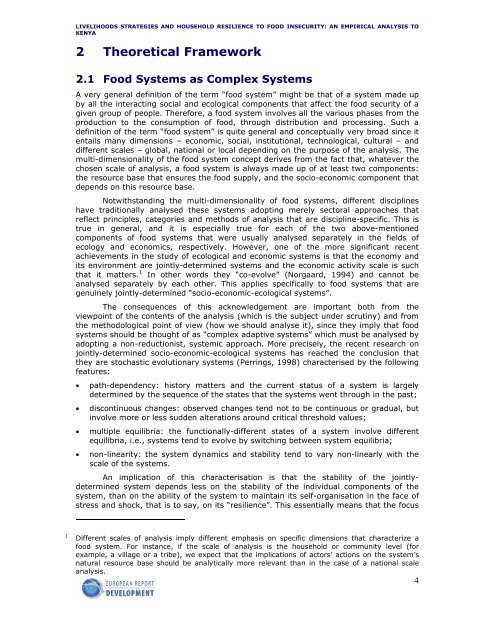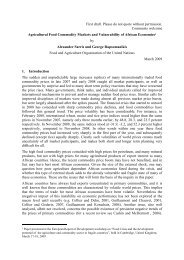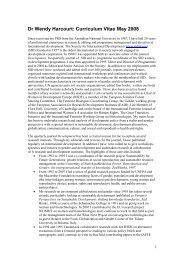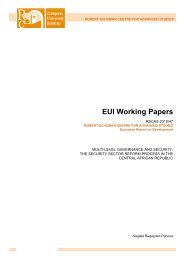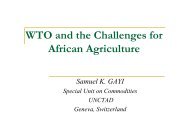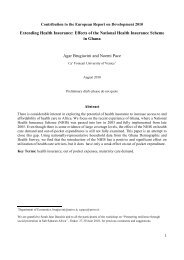LiveLihoods strategies and househoLd resiLience to Food insecurity ...
LiveLihoods strategies and househoLd resiLience to Food insecurity ...
LiveLihoods strategies and househoLd resiLience to Food insecurity ...
You also want an ePaper? Increase the reach of your titles
YUMPU automatically turns print PDFs into web optimized ePapers that Google loves.
LIVELIHOODS STRATEGIES AND HOUSEHOLD RESILIENCE TO FOOD INSECURITY: AN EMPIRICAL ANALYSIS TO<br />
KENYA<br />
2 Theoretical Framework<br />
2.1 <strong>Food</strong> Systems as Complex Systems<br />
A very general definition of the term “food system” might be that of a system made up<br />
by all the interacting social <strong>and</strong> ecological components that affect the food security of a<br />
given group of people. Therefore, a food system involves all the various phases from the<br />
production <strong>to</strong> the consumption of food, through distribution <strong>and</strong> processing. Such a<br />
definition of the term “food system” is quite general <strong>and</strong> conceptually very broad since it<br />
entails many dimensions – economic, social, institutional, technological, cultural – <strong>and</strong><br />
different scales – global, national or local depending on the purpose of the analysis. The<br />
multi-dimensionality of the food system concept derives from the fact that, whatever the<br />
chosen scale of analysis, a food system is always made up of at least two components:<br />
the resource base that ensures the food supply, <strong>and</strong> the socio-economic component that<br />
depends on this resource base.<br />
Notwithst<strong>and</strong>ing the multi-dimensionality of food systems, different disciplines<br />
have traditionally analysed these systems adopting merely sec<strong>to</strong>ral approaches that<br />
reflect principles, categories <strong>and</strong> methods of analysis that are discipline-specific. This is<br />
true in general, <strong>and</strong> it is especially true for each of the two above-mentioned<br />
components of food systems that were usually analysed separately in the fields of<br />
ecology <strong>and</strong> economics, respectively. However, one of the more significant recent<br />
achievements in the study of ecological <strong>and</strong> economic systems is that the economy <strong>and</strong><br />
its environment are jointly-determined systems <strong>and</strong> the economic activity scale is such<br />
that it matters. 1 In other words they “co-evolve” (Norgaard, 1994) <strong>and</strong> cannot be<br />
analysed separately by each other. This applies specifically <strong>to</strong> food systems that are<br />
genuinely jointly-determined “socio-economic-ecological systems”.<br />
The consequences of this acknowledgement are important both from the<br />
viewpoint of the contents of the analysis (which is the subject under scrutiny) <strong>and</strong> from<br />
the methodological point of view (how we should analyse it), since they imply that food<br />
systems should be thought of as “complex adaptive systems” which must be analysed by<br />
adopting a non-reductionist, systemic approach. More precisely, the recent research on<br />
jointly-determined socio-economic-ecological systems has reached the conclusion that<br />
they are s<strong>to</strong>chastic evolutionary systems (Perrings, 1998) characterised by the following<br />
features:<br />
• path-dependency: his<strong>to</strong>ry matters <strong>and</strong> the current status of a system is largely<br />
determined by the sequence of the states that the systems went through in the past;<br />
• discontinuous changes: observed changes tend not <strong>to</strong> be continuous or gradual, but<br />
involve more or less sudden alterations around critical threshold values;<br />
• multiple equilibria: the functionally-different states of a system involve different<br />
equilibria, i.e., systems tend <strong>to</strong> evolve by switching between system equilibria;<br />
• non-linearity: the system dynamics <strong>and</strong> stability tend <strong>to</strong> vary non-linearly with the<br />
scale of the systems.<br />
An implication of this characterisation is that the stability of the jointlydetermined<br />
system depends less on the stability of the individual components of the<br />
system, than on the ability of the system <strong>to</strong> maintain its self-organisation in the face of<br />
stress <strong>and</strong> shock, that is <strong>to</strong> say, on its “resilience”. This essentially means that the focus<br />
1 Different scales of analysis imply different emphasis on specific dimensions that characterize a<br />
food system. For instance, if the scale of analysis is the household or community level (for<br />
example, a village or a tribe), we expect that the implications of ac<strong>to</strong>rs’ actions on the system’s<br />
natural resource base should be analytically more relevant than in the case of a national scale<br />
analysis.<br />
4


